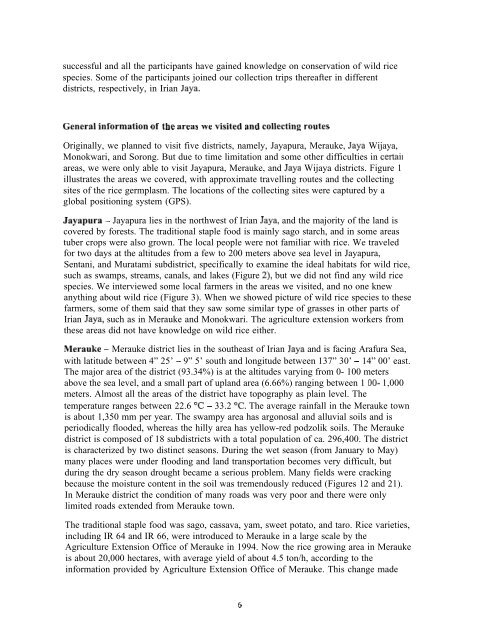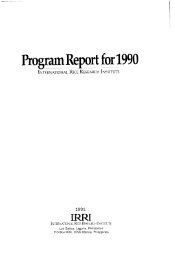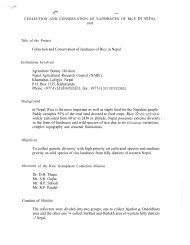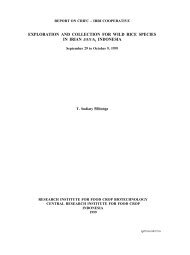Appendix 1 - IRRI
Appendix 1 - IRRI
Appendix 1 - IRRI
Create successful ePaper yourself
Turn your PDF publications into a flip-book with our unique Google optimized e-Paper software.
successful and all the participants have gained knowledge on conservation of wild rice<br />
species. Some of the participants joined our collection trips thereafter in different<br />
districts, respectively, in Irian Jaya.<br />
General information of the areas we visited and collecting routes<br />
Originally, we planned to visit five districts, namely, Jayapura, Merauke, Jaya Wijaya,<br />
Monokwari, and Sorong. But due to time limitation and some other difficulties in certain<br />
areas, we were only able to visit Jayapura, Merauke, and Jaya Wijaya districts. Figure 1<br />
illustrates the areas we covered, with approximate travelling routes and the collecting<br />
sites of the rice germplasm. The locations of the collecting sites were captured by a<br />
global positioning system (GPS).<br />
Jayapura - Jayapura lies in the northwest of Irian Jaya, and the majority of the land is<br />
covered by forests. The traditional staple food is mainly sago starch, and in some areas<br />
tuber crops were also grown. The local people were not familiar with rice. We traveled<br />
for two days at the altitudes from a few to 200 meters above sea level in Jayapura,<br />
Sentani, and Muratami subdistrict, specifically to examine the ideal habitats for wild rice,<br />
such as swamps, streams, canals, and lakes (Figure 2), but we did not find any wild rice<br />
species. We interviewed some local farmers in the areas we visited, and no one knew<br />
anything about wild rice (Figure 3). When we showed picture of wild rice species to these<br />
farmers, some of them said that they saw some similar type of grasses in other parts of<br />
Irian Jaya, such as in Merauke and Monokwari. The agriculture extension workers from<br />
these areas did not have knowledge on wild rice either.<br />
Merauke - Merauke district lies in the southeast of Irian Jaya and is facing Arafura Sea,<br />
with latitude between 4” 25’ - 9” 5’ south and longitude between 137” 30’ - 14” 00’ east.<br />
The major area of the district (93.34%) is at the altitudes varying from 0- 100 meters<br />
above the sea level, and a small part of upland area (6.66%) ranging between 1 OO- 1,000<br />
meters. Almost all the areas of the district have topography as plain level. The<br />
temperature ranges between 22.6 “C - 33.2 “C. The average rainfall in the Merauke town<br />
is about 1,350 mm per year. The swampy area has argonosal and alluvial soils and is<br />
periodically flooded, whereas the hilly area has yellow-red podzolik soils. The Merauke<br />
district is composed of 18 subdistricts with a total population of ca. 296,400. The district<br />
is characterized by two distinct seasons. During the wet season (from January to May)<br />
many places were under flooding and land transportation becomes very difficult, but<br />
during the dry season drought became a serious problem. Many fields were cracking<br />
because the moisture content in the soil was tremendously reduced (Figures 12 and 21).<br />
In Merauke district the condition of many roads was very poor and there were only<br />
limited roads extended from Merauke town.<br />
The traditional staple food was sago, cassava, yam, sweet potato, and taro. Rice varieties,<br />
including IR 64 and IR 66, were introduced to Merauke in a large scale by the<br />
Agriculture Extension Office of Merauke in 1994. Now the rice growing area in Merauke<br />
is about 20,000 hectares, with average yield of about 4.5 ton/h, according to the<br />
information provided by Agriculture Extension Office of Merauke. This change made<br />
6





